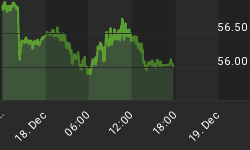Below is an excerpt from a commentary originally posted at www.speculative-investor.com on 29th January 2012.
The three best ways to view the secular stock market trend are via:
1. A long-term chart of the market's price/earnings ratio.
2. A long-term price chart with the price data adjusted for changes in money supply, productivity and population.
3. A long-term chart of the market's performance relative to gold.
One reason that these are effective methods of viewing the secular trend is that they remove changes in currency purchasing power from the picture. An alternative would be to look at a chart showing performance in nominal currency terms, but such a chart could be deceptive due to the real trend being masked by currency depreciation.
The US stock market's real trend was masked by currency depreciation from the mid-1960s through to the early-1980s. During this period, a large reduction in the US dollar's purchasing power transformed a major downward trend into a horizontal trading range. Something similar has happened over the past 12 years.
After we remove changes in the US dollar's purchasing power from the equation it not only becomes clear that the US stock market has been in a secular decline over the past 12 years, but also that the US stock market's most recent secular decline is unfolding in a similar way to the preceding episode (the secular bear market that lasted from the mid-1960s through to the early-1980s). The similarities are illustrated below via charts of the Dow/gold ratio.

Considering the hugely different interest-rate backdrops and the other important differences between the past 12 years and the first 12 years of the previous secular decline, the Dow's similar performance in gold terms during the two periods is remarkable. We note, for instance, that the rate of decline has been roughly the same. There was greater volatility in the Dow/gold ratio during the 1970s than there has been over the past several years, but this is probably due to the gold price being fixed at an artificially low level up until 1971 and then making a rapid catch-up move.
If the duration of the current secular bear market turns out to be the same as the duration of the preceding one, then the Dow/gold ratio will reach its ultimate low during the first half of 2014. But whenever it occurs, the ultimate low will likely come at the end of an upside blow-off in the gold price.
We aren’t offering a free trial subscription at this time, but free samples of our work (excerpts from our regular commentaries) can be viewed at: http://www.speculative-investor.com/new/freesamples.html
















